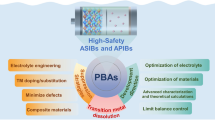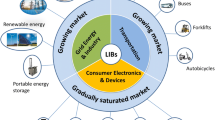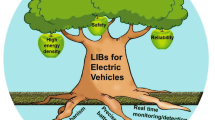Abstract
Lithium-ion batteries are electrochemical storage devices that occupy an important place today in the field of renewable energy applications. However, challenging requirements of lithium-iron-phosphate LiFePO4 (LFP) batteries in terms of performances, safety and lifetime must to be met for increase their integrations in these applications. It is important to identify the origins and symptoms of battery aging and to quantify the various aging modes. In this context, the aim of this paper is to develop a reliability approach which ensures the evaluation of LFP batteries aging using causal tree analysis and electrical equivalent circuit model. The causal tree enables a good understanding of common aging modes such as the loss of lithium inventory, loss of active mass, electrolyte degradation and corrosion of the current collectors and a comprehensive identification of their potential causes. The determination of electric equivalent model parameters is based on experimental voltage responses under different discharge rates and operating temperatures. This experimental study allows creating database parameters of a new battery, which takes into account the temperature effect using the fuzzy logic method. The proposed diagnostic system is based on the use of electrochemical impedance spectroscopy (EIS) technique to determine the parameters of used battery and compared them to the parameters of new battery. The comparison results allow quantifying the depth of the various aging modes as well as the number of remaining cycles. This study is completed by testing three LFP batteries that give insights into the feasibility and efficiency of the proposed diagnostic method.













Similar content being viewed by others
References
Fuengwarodsakul NH (2016) Battery management system with active inrush current control for Li-ion battery in light electric vehicles. Electr Eng 98:17–27. https://doi.org/10.1007/s00202-015-0344-3
Yang LY, Ai OC, Hamidi MN (2020) Performance evaluation of grid-connected power conversion systems integrated with real-time battery monitoring in a battery energy storage system. Electr Eng 102:245–258. https://doi.org/10.1007/s00202-019-00865-y
Han X, Lu L, Zheng Y, Feng X, Li Z, Li J, Ouyang M (2019) A review on the key issues of the lithium ion battery degradation among the whole life cycle. eTransportation 1:100005. https://doi.org/10.1016/j.etran.2019.100005
Azzouz I, Hammami I, Brik K, Ben Ammar F (2020) Criticality assessment with Pareto diagram of the different solar batteries technologies. 17th International Multi-Conference on Systems, Signals & Devices (SSD), 513–518 https://doi.org/10.1109/SSD49366.2020.9364179
Vetter J, Novak P, Wagner MR, Veit C, Moller KC, Besenhard JO, Winter M, Wohlfahrt-Mehrens M, Vogler C, Hammouche A (2005) Ageing mechanisms in lithium-ion batteries. J Power Sour 147:269–281. https://doi.org/10.1016/j.jpowsour.2005.01.006
Wu C, Zhu C, Ge Y, Zhao Y (2015) A Review on fault mechanism and diagnosis approach for Li-Ion batteries. J Nanomater. https://doi.org/10.1155/2015/631263
Lin C, Tang A, Mu H, Wang W, Wang C (2015) Aging mechanisms of electrode materials in Lithium-Ion batteries for electric vehicles. J Chem. https://doi.org/10.1155/2015/104673
Omar N, Abdel MM, Firouz Y, Salminen J, Smekens J, Hegazy O, Gaulous H, Mulder G, Van den Bossche P, Coosemans T, Van Mierlo J (2014) Lithium iron phosphate based battery–Assessment of the aging parameters and development of cycle life model. Appl Energy 113:1575–1585. https://doi.org/10.1016/j.apenergy.2013.09.003
Beltran H, Ayuso P, Pérez E (2020) Lifetime expectancy of Li-Ion batteries used for residential solar storage. Energies 13(3):568. https://doi.org/10.3390/en13030568
Stroe DI, Swierczynski M, Stan AI, Knap V, Teodorescu R, Andreasen SJ (2014) Diagnosis of Lithium-Ion batteries State-of-Health based on electrochemical impedance spectroscopy technique. IEEE ECCE. https://doi.org/10.1109/ECCE.2014.6954027
She C, Wang Z, Sun F, Liu P, Zhang L (2020) Battery aging assessment for real-world electric buses based on incremental Capacity analysis and radial basis function neural network. IEEE Trans Industr Inf 16:3345–3354. https://doi.org/10.1109/TII.2019.2951843
Xiong R, Wang J, Shen W, Tian J, Mu H (2021) Co-estimation of State of charge and capacity for Lithium-ion batteries with multi-stage model fusion method. Engineering. https://doi.org/10.1016/j.eng.2020.10.022
Henschel J, Horsthemke F, Philipp SY, Evertz M, Kösters K, Wiemers-Meyer S, Winter M, Nowak S (2020) Lithium ion battery electrolyte degradation of field-tested electric vehicle battery cells–A comprehensive analytical study. J Power Sources 447:227370. https://doi.org/10.1016/j.jpowsour.2019.227370
Hendricks C, Williard N, Mathew S, Pecht M (2015) A failure modes, mechanisms, and effects analysis (FMMEA) of lithium-ion batteries. J Power Sour 297:113–120. https://doi.org/10.1016/j.jpowsour.2015.07.100
Wang Q, Wang Z, Zhang L, Liu P, Zhang Z (2020) A novel consistency evaluation method for series-connected battery systems based on real-world operation data. IEEE Trans Transp Electr. https://doi.org/10.1109/TTE.2020.3018143
Birkl CR, Roberts MR, McTurk E, Bruce PG, Howey DA (2017) Degradation diagnostics for lithium ion cells. J Power Sour 341:373–386. https://doi.org/10.1016/j.jpowsour.2016.12.011
Pastor-Fernández C, Uddin K, Chouchelamane GH, Dhammika WW, Marco J (2017) A Comparison between electrochemical impedance spectroscopy and incremental capacity-differential voltage as Li-ion diagnostic techniques to identify and quantify the effects of degradation modes within battery management systems. J Power Sour 360:301–318. https://doi.org/10.1016/j.jpowsour.2017.03.042
Agubra V, Fergus J (2013) Lithium Ion battery anode aging mechanisms. Materials 6(4):1310–1325. https://doi.org/10.3390/ma6041310
Miao Y, Hynan P, Jouanne A, Yokochi A (2019) Current Li-Ion battery technologies in electric vehicles and opportunities for advancements. Energies 12(6):1074. https://doi.org/10.3390/en12061074
Wikner E, Thiringer T (2018) Extending battery lifetime by avoiding high SOC. Appl Sci 8(10):1825. https://doi.org/10.3390/app8101825
Zhu J, Sun Z, Wei X, Dai H (2017) Battery internal temperature estimation for LiFePO4 battery based on impedance phase shift UNDER operating conditions. Energies 10(1):60. https://doi.org/10.3390/en10010060
Beletskii EV, Alekseeva EV, Spiridonova DV, Yankin AN, Levin OV (2019) Overcharge cycling effect on the surface layers and crystalline structure of LiFePO4 cathodes of Li-Ion batteries. Energies 12(24):4652. https://doi.org/10.3390/en12244652
Preger Y, Barkholtz HM, Fresquez A, Campbell DL, Juba BW, Romàn-Kustas J, Ferreira SR, Chalamala B (2020) Degradation of commercial Lithium-Ion cells as a function of chemistry and cycling conditions. J Electrochem Soc 167:120532. https://doi.org/10.1149/1945-7111/abae37
Yuan L, Wang Z, Zhang W, Hu X, Chen J, Huang Y, Goodenough JB (2011) Development and challenges of LiFePO4 cathode material for lithium-ion batteries. Energy Environ Sci 4:269–284. https://doi.org/10.1039/C0EE00029A
Kabir MM, Demirocak DE (2017) Degradation mechanisms in Li-ion batteries: a state-of-the-art review. Int J Energy Res 41(14):1963–1986. https://doi.org/10.1002/er.3762
Wojciechowski J, Kolanowski Ł, Bund A, Lota G (2017) The influence of current collector corrosion on the performance of electrochemical capacitors. J Power Sour 368:18–29. https://doi.org/10.1016/j.jpowsour.2017.09.069
Tomaszewska A, Chu Z, Feng X, O’Kane S, Liu X, Chen J, Ji C, Endler E, Li R, Liu L, Li Y, Zheng S, Vetterlein S, Gao M, Du J, Parkes M, Ouyang M, Marinescu M, Wu B (2019) Lithium-ion battery fast charging: a review. TeTransportation. 1:100011. https://doi.org/10.1016/j.etran.2019.100011
Camacho-Forero LE, Balbuena PB (2020) Effects of charged interfaces on electrolyte decomposition at the lithium metal anode. J Power Sour 472:228449. https://doi.org/10.1016/j.jpowsour.2020.228449
Rosenberg E, Kanakaki C, Amon A, Gocheva I, Trifonova A (2017) Understanding the degradation processes of the electrolyte of lithium ion batteries by chromatographic analysis. Bulg Chem Commun 49:242–253
Brik K, Ben Ammar F, Djerdir A, Miraoui A (2015) Causal and fault Trees analysis of proton exchange membrane fuel cell degradation. J Fuel Cell Sci Technol 12(5):051002. https://doi.org/10.1115/1.4031584
Yahmadi R, Brik K, Ben AF (2018) Causal tree analysis for quality control of the lead acid battery manufacturing process. Int J Energy Res 2018:1–22. https://doi.org/10.1002/er.3987
Saeed MS, Schaltz E, Knudsen KS (2019) An electrical equivalent circuit model of a Lithium Titanate Oxide battery. Batteries 5(1):31. https://doi.org/10.3390/batteries5010031
Yu Y, Narayan N, Vega-Garita V, Popovic-Gerber J, Qin Z, Wagemaker M, Bauer P, Zeman M (2018) Constructing accurate equivalent electrical circuit models of Lithium Iron phosphate and Lead-Acid battery cells for solar home system applications. Energy (Oxf) 11(9):2305. https://doi.org/10.3390/en11092305
Author information
Authors and Affiliations
Corresponding author
Additional information
Publisher's Note
Springer Nature remains neutral with regard to jurisdictional claims in published maps and institutional affiliations.
Rights and permissions
About this article
Cite this article
Azzouz, I., Yahmadi, R., Brik, K. et al. Analysis of the critical failure modes and developing an aging assessment methodology for lithium iron phosphate batteries. Electr Eng 104, 27–43 (2022). https://doi.org/10.1007/s00202-021-01320-7
Received:
Accepted:
Published:
Issue Date:
DOI: https://doi.org/10.1007/s00202-021-01320-7




